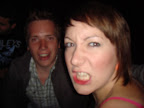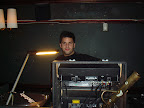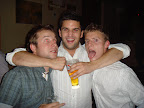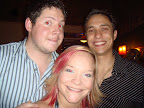Been a while since I have posted about LieroXNA but I havent been doing nothing. Changes and things:
+ Added a destroyed layer to the game which is just the initial map but darker.
+ Added a shadow to the foreground to give it a more 3D appearence.
+ Added an indestructable layer, so that maps can have abit of structure even after a long battle.
+ Added the ability to zoom in and out. This was a big one and took most of last weekend to sort out.
+ Added player spawning.
+ Added the ability to control the player with the 360 controller.
+ Started to add other gameplay features such as player jumps, crosshair, weapon switching things and others.
Anyways you can see all these new features in action in the video below. Again, you can download a higher quality one if you wish: [download#1]
<
Sunday, 30 September 2007
LieroXNA - Improvements and Additions
Wednesday, 26 September 2007
Sunday, 16 September 2007
LieroXNA - Weapons and Forces
I have been working hard on LieroXNA this weekend and have managed to get quite abit of what I wanted done.
Firstly I worked on setting up a framework for weapons that allows them to be described by an external xml. This should reduce the effort involved in creating new weapons in the future. Taking a quick look at the XML that describes the rocket weapon you can see its straight forward but also pretty powerful:
<?xml version="1.0" encoding="utf-8" ?>
<weapon name="Rocket" type="projectile">
<properties>
<texture>rocket</texture>
<trail>smoke</trail>
</properties>
<events>
<onTerrainCollide>
<spawn type="explosion" size="64" where="this" velocity="this" />
<spawn type="shrapnel" quantity="10" where="this" velocity="this" />
<die/>
</onTerrainCollide>
</events>
</weapon>
In addition I have been working on adding forces into the game. It took abit of tweaking but now explosions have a force which repels particles around it, you can see this in action in the video below. I have also added a "vortex" special weapon that sucks particles towards it which then swirl around until the vortex implodes expelling all the particles.
The size of the world has now been expanded and a simple camera has been added. Previously the intention was the world was to be split into multiple tiles of 1024x768 textures but i have now decided against that due to the level of complexity involved and gone for a system that uses one large texture (2048x2048 currently) instead. I have also changed the texture so its a little less "programmer art" as I was getting some stick for that :P
There is still alot of work to be done but im happy with the way it looks at the moment. You will have to excuse the video quality below, flash isnt the best compression for alot of fast moving small particles.
If you want to see a larger less compressed video (35meg) you can download it HERE.
Firstly I worked on setting up a framework for weapons that allows them to be described by an external xml. This should reduce the effort involved in creating new weapons in the future. Taking a quick look at the XML that describes the rocket weapon you can see its straight forward but also pretty powerful:
<?xml version="1.0" encoding="utf-8" ?>
<weapon name="Rocket" type="projectile">
<properties>
<texture>rocket</texture>
<trail>smoke</trail>
</properties>
<events>
<onTerrainCollide>
<spawn type="explosion" size="64" where="this" velocity="this" />
<spawn type="shrapnel" quantity="10" where="this" velocity="this" />
<die/>
</onTerrainCollide>
</events>
</weapon>
In addition I have been working on adding forces into the game. It took abit of tweaking but now explosions have a force which repels particles around it, you can see this in action in the video below. I have also added a "vortex" special weapon that sucks particles towards it which then swirl around until the vortex implodes expelling all the particles.
The size of the world has now been expanded and a simple camera has been added. Previously the intention was the world was to be split into multiple tiles of 1024x768 textures but i have now decided against that due to the level of complexity involved and gone for a system that uses one large texture (2048x2048 currently) instead. I have also changed the texture so its a little less "programmer art" as I was getting some stick for that :P
There is still alot of work to be done but im happy with the way it looks at the moment. You will have to excuse the video quality below, flash isnt the best compression for alot of fast moving small particles.
If you want to see a larger less compressed video (35meg) you can download it HERE.
Wednesday, 12 September 2007
I cant stop playing with particles..
Well I have been at it again, tweaking and altering the particles in LieroXNA. You can see a video of my results below.
+ Particles now represent the pixel they exploded from. i.e. if the terrain was green the particle is green, if it was blue the particle is blue etc.
+ Particles are now more white (hot) depending on how fast and how old they are.
+ Particles now explode in a circular direction and less randomly (looks more like an explosion).
+ Particles now have a direction from which they are exploded, at the moment is just current mouse position - last mouse position but in the future this will be used to blow particles away from a high energy collision.
+ Particles now react to the player. I realised that instead of just passing in the terrain texture to the particle update routine i could pass the entire back buffer allowing the player and any other objects in the scene to have particle reactions, yey!
+ Particles now have a bit of alpha blending to make them look a little less in focus, not sure if this works well, let me know :)
Monday, 10 September 2007
Liero Update - Console & ATi
Well I took Liero into work today just to show to a few people who were interested and to test it on another machine other than my own. And low and behold it didnt work on my work machine which was no surprise as it doesnt have a graphics card so it fell down at the first hurdle. I then went to test it on an artists ATi based machine expecting it to work. It did but sadly there were no particles.
Well after digging around abit, I discovered that it was the same problem I encountered before when I released my 1,000,000 particles demo a few months ago. The problem is that ATi dont include the ability to use Vertex Textures in their graphics hardware (the core technology allowing me to get many particles on the screen). I knew the solution from previous work was to use ATi's alternative Renter To Vertex Buffer (R2VB) unfortunately I could not find anyone else that had done this in XNA before which led me to the suspicion that it wasnt possible. I posted on the XNA forum about this, you can see the replies here.
Anyways to cut a long story short I have not been able to implement R2VB for ATi cards but I have instead done the next best thing which is to implement a CPU particle system instead. This means that people with realy old cards (or like my work machine without a card atall) or people with ATi cards they can still play the game and still have particles, just not as many (200-400k on nVidia, 10-50k on CPU).
Also something I implemented over the weekend was this fancy console which, makes life alot easier for me when developing, isnt it nice ;)

Well after digging around abit, I discovered that it was the same problem I encountered before when I released my 1,000,000 particles demo a few months ago. The problem is that ATi dont include the ability to use Vertex Textures in their graphics hardware (the core technology allowing me to get many particles on the screen). I knew the solution from previous work was to use ATi's alternative Renter To Vertex Buffer (R2VB) unfortunately I could not find anyone else that had done this in XNA before which led me to the suspicion that it wasnt possible. I posted on the XNA forum about this, you can see the replies here.
Anyways to cut a long story short I have not been able to implement R2VB for ATi cards but I have instead done the next best thing which is to implement a CPU particle system instead. This means that people with realy old cards (or like my work machine without a card atall) or people with ATi cards they can still play the game and still have particles, just not as many (200-400k on nVidia, 10-50k on CPU).
Also something I implemented over the weekend was this fancy console which, makes life alot easier for me when developing, isnt it nice ;)
Sunday, 9 September 2007
Liero + 200,000 Particles
Been workin on this abit this weekend and managed to intergrate my earlier work on GPU particles with the game to create some nice effects. See the video below to see thousands of particles being blown in many different directions.
Saturday, 8 September 2007
Some more pics up
Just got back from Phil's 23rd party and Jen's 21st. As usual I have uploaded the pics to my picassa account.
Some highlights include:




Some highlights include:
Thursday, 6 September 2007
LieroXNA - A Tentative Beginning
Okay I have decided to start a new mini pet project. As you may have guessed by now I have stopped work on the TDProject. The reason is that it is too large of a project to take on at the same time as having a job, should I ever find myself without a job in the future I may pick it up again.
So the new project is designed to be alot smaller than the last and should give a more immediate sense of achievement. The project is going to be a clone of the popular game Liero but for XNA (so xbox eventualy). For those that havent played it, its a real-time 2D action game (basically worms without the turn based tedium).
So far im just playing around with getting the core of the engine up and running. The original Liero and its successive clones were all done in C/C++. In those languages you have the ability to pixel blit, that is write directly to the back buffer one pixel at a time. In XNA/C# however you dont have that ability, so you have to do some funky stuff with shaders. The advantage of doing it this way however is that GPU particles that have physics (can bounce around the level) should fall out of the code nicely allowing for large numbers of particles.
Anyways, as I said its just a beginning for now. So far I have a level rendered with a terrain map, an explosion map (renders explosions to the texture each frame if any occurred) and a collision map which allows objects to collide. With the left mouse button you can blow holes in the terrain which in turn updates the collision map allowing the worm to move around more of the level.

So the new project is designed to be alot smaller than the last and should give a more immediate sense of achievement. The project is going to be a clone of the popular game Liero but for XNA (so xbox eventualy). For those that havent played it, its a real-time 2D action game (basically worms without the turn based tedium).
So far im just playing around with getting the core of the engine up and running. The original Liero and its successive clones were all done in C/C++. In those languages you have the ability to pixel blit, that is write directly to the back buffer one pixel at a time. In XNA/C# however you dont have that ability, so you have to do some funky stuff with shaders. The advantage of doing it this way however is that GPU particles that have physics (can bounce around the level) should fall out of the code nicely allowing for large numbers of particles.
Anyways, as I said its just a beginning for now. So far I have a level rendered with a terrain map, an explosion map (renders explosions to the texture each frame if any occurred) and a collision map which allows objects to collide. With the left mouse button you can blow holes in the terrain which in turn updates the collision map allowing the worm to move around more of the level.
Subscribe to:
Comments (Atom)